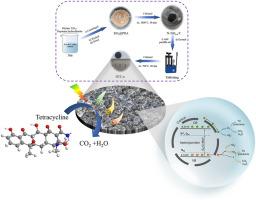具有 N 掺杂、氧空位和碳层的多多巴胺功能化 TiO2,可提高光电催化性能。
IF 7.7
2区 环境科学与生态学
Q1 ENVIRONMENTAL SCIENCES
引用次数: 0
摘要
对于基于 TiO2 的光电催化技术而言,开发一种既具有出色的重复使用性又具有简单制备工艺的光电极板仍然是一项极具挑战性的任务。在此,我们通过 "碳热还原-压制-煅烧 "方法制备了一种具有 N 掺杂、氧空位(Ovs)和碳层(NTC)的三维光电极。该光电二极管在 60 分钟内降解了 97.94% 的四环素(TC)。这种降解的一阶动力学常数是 TiO2-x 的 28.3 倍,光电协同系数高达 13.9。该光电电极对 pH 值、电解质浓度、阴离子等的抗干扰能力也非常突出,适用于不同的水基质和各种抗生素的去除。特别是,20 个循环后 TC 的降解效率仅下降了 1.33%,这表明 NTC 具有极佳的重复使用性。此外,光激发空穴(h+)是主要的活性物种,单线态氧(1O2)和超氧自由基(-O2-)在去除三氯甲烷中起辅助作用。最后,提出了三氯乙酸的可能降解途径,并通过毒性评估软件工具(T.E.S.T)和植物毒性实验证明这些途径能有效降低污染物的毒性。这一进展可能会为设计和建造基于 TiO2 的光电电极带来新的启示。本文章由计算机程序翻译,如有差异,请以英文原文为准。

Polydopamine functionalized TiO2 with N doping, oxygen vacancies, and carbon layers for enhanced photoelectrocatalytic performance
The development of a photoelectrode featuring both excellent reusability and a simple preparation process remains exceptionally challenging for TiO2-based photoelectrocatalytic technology. Herein, a three-dimensional photoelectrode with N doping, oxygen vacancies (Ovs), and carbon layers (NTC) was prepared via the "carbothermal reduction-pressing-calcination" method. The photoelectrode degraded 97.94% of tetracycline (TC) within 60 min. The first-order kinetic constant for this degradation was 27.3 times higher than that of TiO2-x, and the photoelectric synergy factor reached as high as 13.9. The photoelectrode also demonstrated outstanding anti-interference capability for pH, electrolyte concentration, anions, etc., and was suitable for different water matrixes and various antibiotics removal. In particular, the degradation efficiency of TC decreased by only 1.33% after 20 cycles, demonstrating the excellent reusability of NTC. Furthermore, photoexcited holes (h+) were the dominant active species, and singlet oxygen (1O2) and superoxide radicals (•O2−) played an auxiliary role in removing TC. Finally, possible degradation pathways for TC were proposed and demonstrated to be effective in reducing the toxicity of the pollutant by the Toxicity Evaluation Software Tool (T.E.S.T) and phytotoxicity experiments. This progress might bring new insights into the design and construction of TiO2-based photoelectrodes.
求助全文
通过发布文献求助,成功后即可免费获取论文全文。
去求助
来源期刊

Environmental Research
环境科学-公共卫生、环境卫生与职业卫生
CiteScore
12.60
自引率
8.40%
发文量
2480
审稿时长
4.7 months
期刊介绍:
The Environmental Research journal presents a broad range of interdisciplinary research, focused on addressing worldwide environmental concerns and featuring innovative findings. Our publication strives to explore relevant anthropogenic issues across various environmental sectors, showcasing practical applications in real-life settings.
 求助内容:
求助内容: 应助结果提醒方式:
应助结果提醒方式:


